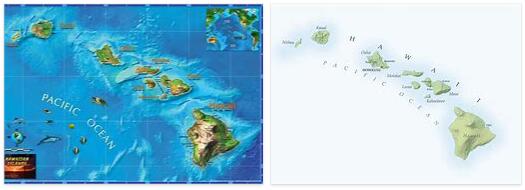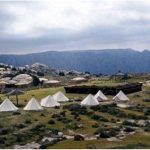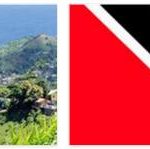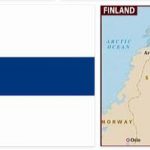Climate and hydrography. – Although located just to the south of the Tropic of Cancer, the Hawaiian Islands, being surrounded by large oceanic areas, enjoy a much cooler and more uniform climate than that of many other regions located at the same latitude. The dominant element is the trade wind, which blows continuously from the northeast for 8 months of the year: during the other 4 months, that is from December to March, the dominant wind is that of southwest , locally called kona. The windswept northeastern regions are generally humid and often rich in vegetation, while the sheltered southwestern regions are sometimes arid. The following picture shows the main climate data of Honolulu:
Due to their prevalent mountainous character, there are no important rivers in the islands, but only streams that flow within narrow and sunken gorges, characteristic of the region.
Flora. – The original vegetation has largely disappeared due to the extension of crops. However, the higher mountainous areas facing the wind are still partly covered by ancient forests. The early Hawaiians had to import numerous useful plants to the islands, including breadfruit, coconut, banana, taro, sugar cane and mulberry. From the kukui or candle tree the natives obtained the means of illumination, and with the fibers of the hala they made interweaving works. Almost all the tropical fruit trees introduced by the white settlers have taken root very well: many of them, including orange, lemon, mango, are now also found in the wild.
According to acronymmonster, the flora of the Hawaiian archipelago has been defined as a mixture of components with American and Malay affinities, with the former predominating. More precisely, the most recent scholars (Skottsberg) distinguish three different components; paleotropical, consisting of Polynesian, Indo-Malay and endemic species and widespread in the lower plain and in the middle mountain plain; Antarctic, characteristic of humid and cool mountain stations, with genera such as Oreobolus, Astelia, Acaena, Gunnera, Lagenophora; and paleopacific, very varied in turn, so much so that a greater progress of knowledge will probably allow it to be distinguished in the future in smaller groupings, representing 61% of the flora of the upper mountain plain and 32% of the total flora of the archipelago. In the flora as a whole, endemism assumes exceptional proportions; in fact out of 739 species of phanerogams, 575, that is about 80%, are exclusive to Hawaii (Hildebrand), with special representation of the families of the Composites, Lobeliacee, Rubiaceae, Labiate, Graminaceae, Ciperaceae, Rutaceae, Cariofillaceae, Cirtandraceae, Leguminosae, Solanaceae, Euphorbiacee, Piperaceae (Mann).
The botanical landscape of the archipelago then presents first of all a lower level, between the coast and 300 meters above sea level, occupied by formations of grasses scattered with tropical trees, followed by a tropical forest, extending between 600 and 1800 m. s. m. and characterized by the diffusion of Acacia koa, a species which, like the Bourbon Acacia heterophylla, to which it is closely related, partially replaces its pinnate leaves with phyllodes. This tree, which is the largest in Hawaii, is accompanied by a compact undergrowth of evergreen trees and shrubs, many of which belong to families and genera that lack wood species elsewhere: Violacee (Isodendron),), Geraniacee (Geranium arboreum); or that rarely present them: Composite (Gailliardia, Wilkesia, Hesperomannia). In this very rich and interesting flora, epiphytic orchids and species of the genus Ficus are missing, which would represent Asian affinities. On an upper mountain level, reaching the limit of the arboreal vegetation at 2800 meters above sea level, there are bushes composed of small trees (Sophora) or shrubs (Vaccinium, Railliardia, Argyroxiphium, etc.), while a leguminous plant (Edwardsia grandiflora, name loc. manati), even 6-10 meters high, goes up to 3346 meters on the Maunakea, that is, just below the extreme limit of the grassy and poor vegetation of the few peaks that rise above the limit of the woods.
The study of this hypsophilic flora, moreover, scarce in species, but more markedly endemic than all the rest of the vegetation, has had great importance in the discussion on the origin of the vegetal covering of such an isolated district as the Hawaiian archipelago.. Suffice it to mention here that, contrary to the opinion of the Guppy, who, in his book on the vegetation of the Pacific islands, attached considerable importance to remote dissemination to justify the population of Hawaii, Skottsberg has recently summarized the very serious reasons for which it can be said that the endemics currently located on the volcanic peaks of recent origin of the archipelago belong to a
Fauna. – The fauna of the Hawaiian Islands is extraordinarily rich and interesting. Mammals, except those imported by man, are missing. An exception is only one species of bat, characteristic of these islands, the Atalapha Grayi, belonging to an American genus.
Birds are represented by numerous species, many of which are exclusive to the islands. Among the aquatic ones, a good number are characteristic of Hawaii, while the rest are common to the other Pacific islands. The exclusive presence of an entire family of Passerines, the Drepanids, with a beak of singularly varied forms, rich in many species, is the main feature of the Hawaiian ornithic fauna. The species of this singular family are strictly localized in the various islands of the archipelago. The herpetological fauna is very scarce and consists of some species of saurians among which a geko, the Hemiphyllodactylus leucostictus, is characteristic. Among the Amphibîs, a species of toad is notable, the Bufo dialopus. The world of insects is extraordinarily rich, represented by more than 3300 species, of which about 2700 are endemic. These are generally small, apterous or reduced-winged forms. Terrestrial molluscs live in Hawaii with about 400 species, of which three quarters belong to the Achatinellidae family, and are exclusive to the islands, where they were also found in the fossil state. The species of this family are then localized in certain islands of the archipelago.






